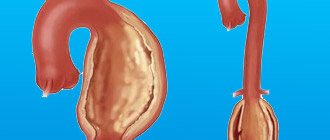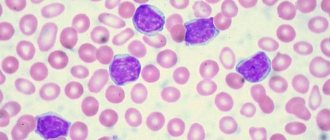To the reference book Wegener's granulomatosis involves damage to the upper respiratory tract.
Author:
- Oganesyan Tigran Sergeevich
ENT pathology expert
5.00 (Votes: 1)
Wegener's granulomatosis is a granulomatous vasculitis characterized by damage to the upper respiratory tract, first described in the first third of the 20th century by the German physician Friedrich Wegener, for which it received its name.
The disease is predominantly necrotic in nature; with a long course, the lungs and kidneys are involved in the process.
Clinical picture
There are several forms of pathology - acute, subacute and chronic. The development of the disease also describes three main stages:
- initial - changes in the upper respiratory tract are local in nature (the mucous membranes of the nasal cavity, pharynx, larynx, trachea, and sometimes the middle ear are affected);
- generalized - the process of damage involves internal organs, lungs and kidneys in particular;
- terminal - the most severe, aggravated by the addition of renal, pulmonary and heart failure.
In this regard, patients complain about:
- nasal congestion (usually one half);
- purulent nasal discharge mixed with blood;
- brown-brown crusts form on the mucous membrane, after removal of which it has a thinned appearance and is covered with bleeding lesions.
In the case of further progression of the disease, perforation of the cartilaginous and then the bone part of the septum occurs (saddle-shaped perforation of the nose). After which nearby tissues, especially the paranasal sinuses, are destroyed. A distinctive feature of granulomatosis from syphilis is the absence of destruction of the hard palate, which in this case remains unchanged.
The generalized stage of the pathology is usually diagnosed after several months or even after several years. Damage to the lungs will be marked by the appearance of cough, shortness of breath, and characteristic chest pain. The skin also signals changes occurring in the body; ulcerative necrotic rashes appear on it.
Severe, terminal stage granulomatosis is life-threatening. The symptoms of azotemic uremia are accompanied by signs of pulmonary and heart failure, which together are the cause of death.
Diagnostics
In patients with a developed clinical picture, the diagnosis is usually simple, but due to the variety of forms and course options, difficulties arise in the early stages of the disease. Approximately 25% of patients in the initial stage have no signs of lung or kidney damage.
Classification criteria for the diagnosis of Wegener's granulomatosis
| Criterion | Definition |
| 1. Inflammation of the nose and mouth | Ulcers in the mouth. Purulent or bloody discharge from the nasal cavity |
| 2. Changes in X-ray examination of the lungs | Nodules, infiltrates or cavities |
| 3. Changes in urine | Microhematuria (>5 red blood cells per field of view) or accumulations of red blood cells in urine sediment |
| 4. Biopsy | Granulomatous inflammation in the arterial wall or in the perivascular and extravascular spaces |
If two or more criteria are present, the sensitivity of diagnosis is 88% and the specificity is 92%. To confirm the diagnosis, the presence of classical antineutrophil cytoplasmic antibodies (cANCA) in the blood is determined.
Symptoms
Symptoms of sarcoidosis include the following:
- Labored breathing. This is especially noticeable at first during physical activity - even quite moderate ones.
- Problems with appetite, sudden weight loss.
- Weakness in muscles, tendency to fatigue.
- Dry cough, expectoration of blood.
- Painful sensations in the chest.
- Redness of the skin as a result of a strong rush of blood.
All these symptoms of sarcoidosis should immediately alert the patient and force him to seek specialist help. Pulmonologists deal with this disease, but if you doubt the first signs of the disease, you can also contact a general practitioner, who will then refer you to the right doctor.
How is the disease treated in Israel?
Specialists of the KeyMedical medical consortium use various techniques in cases of diagnosed Wegener's granulomatosis. However, drug therapy remains the main and most effective. Most often, inpatient treatment is used for Wegener's disease. Before starting treatment, Israeli doctors first conduct a series of diagnostic tests to ensure the diagnosis is correct.
Treatment is carried out by selecting an immunosuppressive therapy regimen. Pulse therapy can also be performed; in the intermediate periods, Methotrexate is prescribed. If we are talking about a disease at stages 2-3, then extracorporeal hemocorrection may be required - in particular, plasmapheresis, cryopheresis and other modern methods from the hemocorrection arsenal are used. In some cases, immunoglobulin therapy is used. If the disease has seriously affected the larynx, then tracheostomy and reanastomosis may be required.
Wegener's granulomatosis very often ends unfavorably for the patient - the fact is that the disease is systemic, and already from the second stage it begins to manifest itself in a generalized form. More and more new granulomas are created in the body, which lead to various complications. In addition, the disease provokes a number of other diseases that significantly weaken the immune system. Practice shows that in 90% of cases, without adequate medical care, patients cannot be saved because the lesions are too serious.
If we are talking about a localized form of Wegener's disease, then in most cases the prognosis is favorable; Israeli specialists often manage to achieve stable remission, which significantly improves the quality of life of patients.
There is practically no prevention for Wegener's disease, since the exact causes of the disease have not yet been established.
Stages
There are three stages of sarcoidosis. At the first stage, there is an increase in lymph nodes, lung damage is either unilateral or symmetrical. The second stage is characterized by the spread of the disease through the lymphatic tract. The granulomas are still small, and the lung tissue gradually begins to be replaced by tissue of higher density.
At the third stage, connective tissue grows in the alveoli and scars form. The risks of complications such as emphysema and pneumosclerosis are high. Often granulomas grow simultaneously in the lungs and in other parts of the body.
Forecast for the development of the disease
The transition of granulomatosis from the initial stage to the terminal stage occurs over a short period.
Moreover, in almost all cases, the infected organism is prone to complications. Among the large number of patients at a late stage there are:
- destruction of facial cartilage and bones;
deafness and blindness;- hemoptysis;
- formation of granulomas;
- gangrene of the foot;
- additional infections;
- renal failure.
Lack of therapy in 97% of cases has an unfavorable prognosis: patients die within a period of six months to two years.
The course of the local form of the disease is benign. Immunosuppressive therapy helps improve the overall state of remission in 80% of patients. In half of the patients, a new exacerbation occurs after a long period.
Symptoms of Wegener's granulomatosis
The main symptoms may be as follows:
- increased sweating;
- weakness;
- increased body temperature;
- chills;
- deformation of the nasal septum;
- constant runny nose.
If the lungs were involved in the pathological process, then a constant cough, often with hemoptysis, is added to the above symptoms. There is also a hemorrhagic rash, decreased hearing and visual acuity, the nervous system and blood vessels are affected, and various complications arise.
Local form
In the local form, an inflammatory process is observed in the nasal mucosa, in the paranasal sinuses, in the pharynx and larynx, in the trachea, in various parts of the visual and auditory analyzers. Patients suffer from constant rhinorrhea and periodic nosebleeds. In addition, nasal breathing is impaired, bloody crusts form in the nose, and the voice becomes hoarse. Many scientists consider the local form of granulomatosis as an independent disease, which is characterized by dominant lesions of the skin and respiratory organs.
Differential diagnosis
For the purpose of correct diagnosis, diseases that also occur with pulmonary-renal syndrome should be excluded: microscopic polyangiitis, Churg-Strauss syndrome, periarteritis nodosa, Goodpasture syndrome, hemorrhagic vasculitis, systemic lupus erythematosus; rarely - streptococcal pneumonia with glomerulonephritis. A differential diagnosis is also carried out with other diseases: lymphoid granulomatosis, angiocentric malignant lymphoma, malignant tumors, median granuloma of the nose, sarcoidosis, tuberculosis, berylliosis, systemic mycoses, syphilis, leprosy, AIDS, etc. With a predominantly renal course, differential diagnosis is carried out with idiopathic rapidly progressive glomerulonephritis .
Medicines
When treating the disease use:
- "Cyclophosphamide", "Methotrexate" and "Azathioprine", which are part of the group of cytostatics.
- "Dexamethasone" and "Prednisolone" are part of the group of glucocorticoids.
- Anticytokine therapy.
- Hemodialysis, cascade plasma filtration, extracorporeal pharmacotherapy, plasmapheresis.
- Antibiotics, which are prescribed to prevent the occurrence of infectious complications.
- Immunoglobulins. May be prescribed if there is a relapsing course of the disease.
Causes and course of the disease
Currently, the causes of this disease are not fully understood, but most researchers are of the opinion that it is an autoimmune disease, in the occurrence of which viruses such as cytomegalovirus and herpes virus play an important role.
An equally important factor is the genetic peculiarity of the immune system, especially since with this disease in the blood of patients there is an increased content of the HLA-A8 antigen, which is responsible for the genetic predisposition to the development of autoimmune diseases. In the pathogenesis of Wegener's granulomatosis, immunological disorders such as deposition of immune complexes in the walls of blood vessels and impaired cellular immunity are of great importance. Patients experience necrotizing vasculitis, which affects medium- and small-caliber arteries and is accompanied by the formation of polymorphic cell granulomas that contain giant cells.
Treatment of orofacial granulomatosis
Orofacial granulomatosis is difficult to treat. It is complex, extended over time and aimed at eliminating symptoms. Its effectiveness has not been definitively confirmed. Treatment may include glucocorticoid therapy (systemic or injection of drugs directly into the lesion) and non-steroidal anti-inflammatory drugs (to eliminate edema); antibiotics, immunosuppressants and surgical methods (for persistent swelling that interferes with speaking and eating, as well as to relieve pressure on the facial nerve). In cases of identified allergies, contact with the antigen should be avoided. Following a diet (excluding cinnamon and benzoates) may improve the patient's condition.
Patients with lesions in the oral cavity may subsequently develop Crohn's disease, so consultation with a gastroenterologist, immunologist, and nutritionist is necessary. Further observation is necessary to exclude the possible development of Crohn's disease and ulcerative colitis.
Features and advantages of treatment of orofacial granulomatosis at the Rassvet clinic
Diagnosis and treatment of rare syndromes and diseases requires the doctor to have deep and specific knowledge that helps to correctly recognize an orphan pathology and prescribe effective treatment.
The Rassvet Clinic has modern and high-precision equipment that allows our doctors to quickly and effectively diagnose and treat any condition, including rare diseases such as orofacial granulomatosis. In our work, we adhere to a multidisciplinary approach, therefore, if necessary, we quickly involve specialists from different fields in the problem: dentists, gastroenterologists, immunologists, nutritionists.
Dawn is evidence-based medicine, treatment based on international protocols, proper communication and patient support.
Material and methods
The pathomorphological features of vascular lesions were studied in 11 people who died from GPA aged 16 to 74 years. Among the patients, men predominated (8 cases). The professional composition was as follows: workers - 2, students - 2, livestock specialist - 1, machinist - 1, pharmacist - 1, employee - 1, housewife - 1, pensioner - 1, student - 1. The duration of the disease ranged from 1 month to 4 years , the course of the disease was acute in four cases, subacute in two and chronic (with periods of exacerbation and remission) in five observations.









